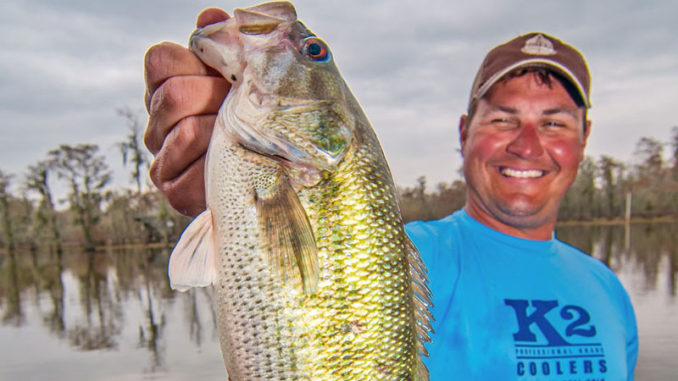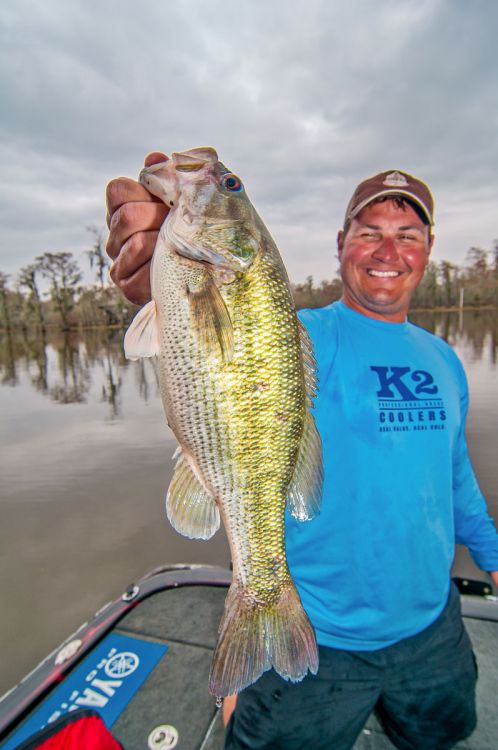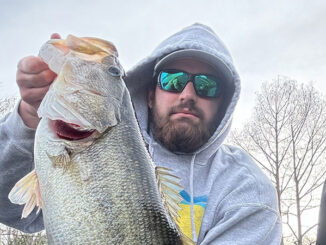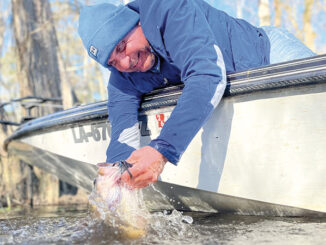
January is when Atchafalaya Basin bass are on the verge of pulling up tight for the spawn, with water temperatures dictating when exactly that happens.
Bass pro Cliff Crochet knows the fish will be staged up near spawning areas, so he’ll be working slow-moving bayous and dead-end canals whenever he’s not traveling for national tournaments.
“Early in the day, you’re dealing with cool mornings, so I’m probably chilling out,” the Pierre Part angler said. “I’m probably going slow, flipping a jig.”
He said casting a ½-ounce black/blue Santone Lures jig and bumping it back to the boat will pick up some bites while he waits on the water to warm just a bit.
“I’m looking for those lazy fish,” Crochet said.
But when the sun gets up and starts pushing water temps upward, Crochet puts down his jig and turns to a winter pattern he said South Louisiana anglers often don’t think about.
“The most overlooked lure in January in the Basin is the square-billed crankbait,” he said.
Crochet said a Luck-E Strike RC2 Series 4 allows him to cover a lot of water and get bites from fish as they gorge for the coming spawn — bass that often won’t hit anything else.
“The jig is on the bottom and a jerk bait is on top, but that square-bill covers everything in between,” he explained. “I think there are certain times the fish are almost suspended.”
He said the larger profile of the Series 4 offers some advantages compared to smaller square-bills.
‘It’s easier to cast, for one,” Crochet said. “It’s also rattling and pushes more water, so it’s creating more commotion down there.
“Especially this time of year, you’re dealing with hungry fish, aggressive fish, so I don’t think you give up anything using a bigger bait.”
Although he bangs the lure off any cover he sees, he isn’t just cranking and winding.
“You can change your retrieve,” he said. “In fact, stop-and-go is a real fun deal.”
So cast the Luck-E Strike square-bill and give it a few cranks — and then stop reeling.
“Crank it six, seven, eight times to get it going, and you can feel the vibration of the bait,” Crochet explained. “You stop it just briefly, and then you’re going again.
“I think it gets you some reaction bites.”

He said it’s important to pay attention to the retrieve, learning what it feels like when the lure stops and starts again.
“When you start (reeling after the pause), you’re going to feel that vibration again,” Crochet said. “You get to know the timing, so when you throw out there, whenever you start again and you don’t feel what you’ve been feeling — that’s when the fish has it.
“A lot of times you’ll start reeling and it’ll feel like you’re in grass. That’s a fish.”
There are times, however, when you start reeling and you feel absolutely nothing.
“It’ll feel like somebody cut your line,” Crochet said. “That’s the fish swimming to you. When that happens, you want to reel, reel, reel until you feel the fish, and then just lean into it.”
Best Basin colors are Cajun Baby red, green copper shad and spotted shad.
To maximize his square-bill efforts, the angler uses a 7-foot, medium/heavy, fast-action Deuce rod; a reel with a 7:1 gear ratio and 20-pound Seaguar Rippin’ monofilament.
The fast reel allows Crochet to get his crankbait rattling again quickly after a pause, while also providing the ability to reel in slack to catch up with fish that run toward the boat.
The heavy mono achieves two things.
“I don’t want to dig this thing — I want to bang it off of everything I can,” Crochet said. “I don’t want it to run more than 2 feet deep; the heavier line helps keep it running 1, 2 feet deep.
“And then I have durability so I don’t have to worry about it breaking.”
The great thing about the lure is that, even though bites might be subtle, a bass usually isn’t playing around when it decides to strike.
“I’ve caught fish on these square-bills that choked on it, have it sideways in their throat — you scratch your knuckles getting it out,” Crochet said. “And those fish wouldn’t hit a jig.”


